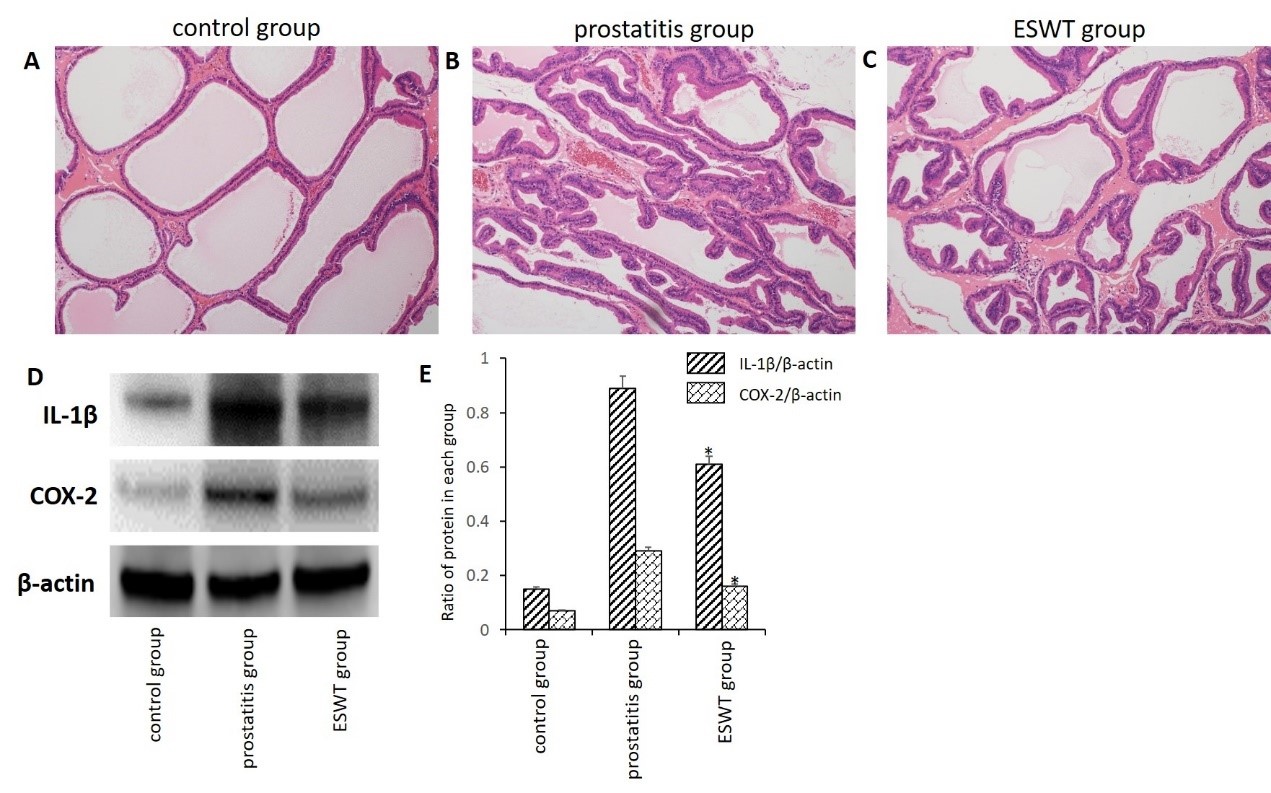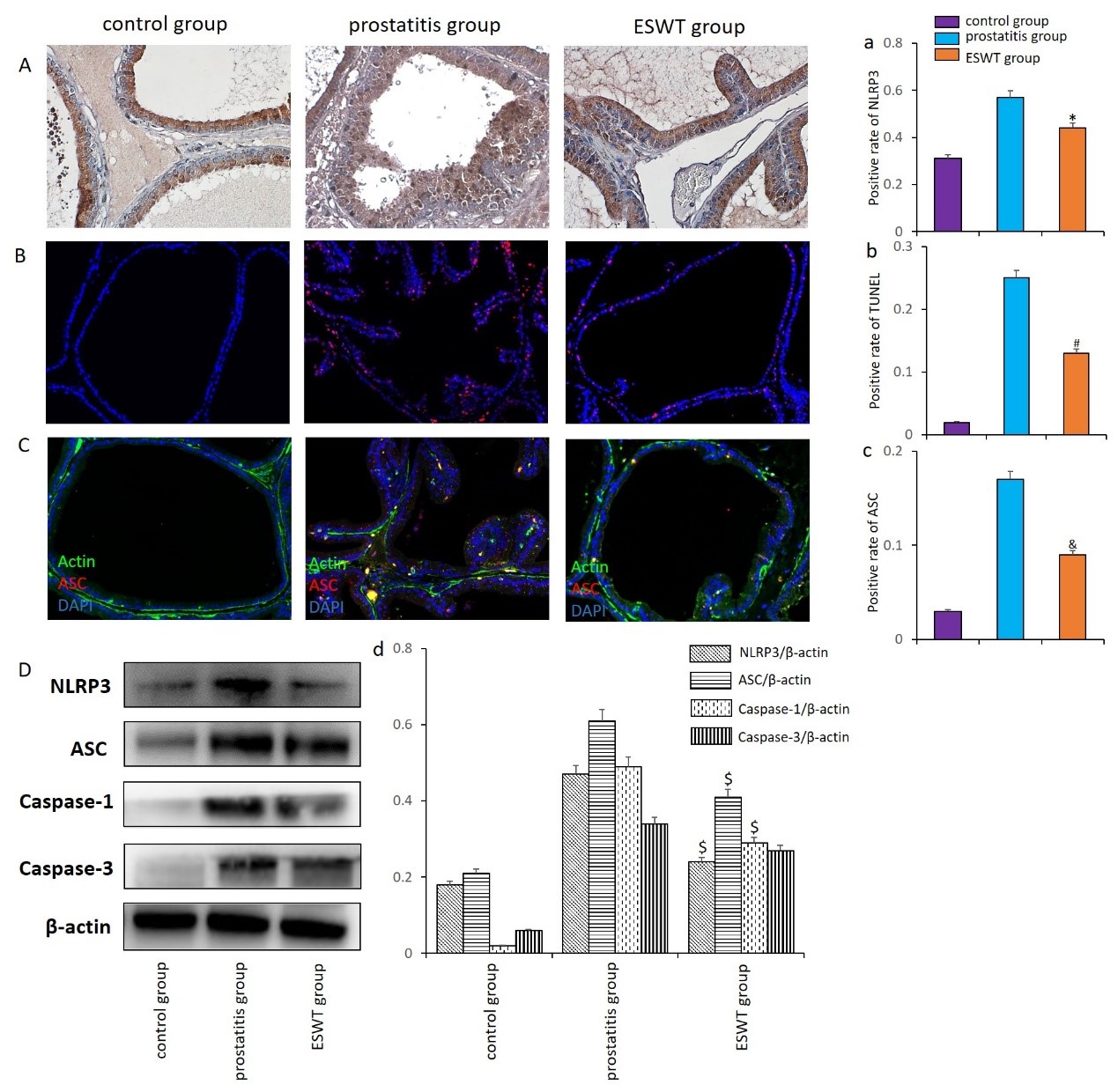Back
Poster, Podium & Video Sessions
Moderated Poster
MP37: Infections/Inflammation/Cystic Disease of the Genitourinary Tract: Prostate & Genitalia
MP37-03: Extracorporeal Shockwave Therapy Improves CP/CPPS by Down-regulating NLPR3 Inflammasome in a Prostatitis Rat Model
Sunday, May 15, 2022
7:00 AM – 8:15 AM
Location: Room 225
Dongho Shin*, Chang Eil Yoon, Hyeok Jae Kwon, Hyong Woo Moon, Yong Hyun Park, Hyuk Jin Cho, U-syn Ha, Sung-Hoo Hong, Sae Woong Kim, Ji Youl Lee, Woong Jin Bae, Seoul, Korea, Republic of
- DS
Dong Ho Shin, MD
College of Medicine, The Catholic University of Korea
Poster Presenter(s)
Introduction: The aim of this study was to evaluate the anti-inflammatory and antioxidative effects of extracorporeal shockwave therapy (ESWT) on prostatitis using in-vitro as well as in-vivo experimental models and explore the mechanism.
Methods: RWPE-1 cells randomly divided into 5 groups: 1 RWPE-1 group (normal control), 2 LPS group (lipopolysaccharide inducing inflammation), 3 0.1ESWT group (treated by 0.1mJ/mm2 ESWT), 4 0.2ESWT group (treated by 0.2mJ/mm2 ESWT) and 5 0.3ESWT group (treated by 0.3mJ/mm2 ESWT). After ESWT administered, cells and supernatant were collected for ELISA and western blot. In vivo, Sprague-Dawley male rats (n=36) were randomly divided into 3 groups: 1 normal group, 2 prostatitis group, and 3 ESWT group (n=12 for each). Prostatitis was induced by 17 beta-estradiol and dihydrotestosterone(DHT) administration. Four weeks after ESWT, pain index was assessed for all groups and prostate tissues were collected for immunohistochemistry, immunofluorescence, apoptosis analysis and Western blot.
Results: The optimal energy flux density of ESWT was 0.2 mJ/mm2 in vitro. ESWT ameliorated discomfort in rats with prostatitis. Inflammation was improved by ESWT in rats with prostatitis (P <0.05). Compared to normal rats, overexpressed NLRP3 inflammasomes triggered apoptosis which was improved by ESWT in prostatitis (P <0.05). TLR4-NF?B pathway was overactive with prostatitis, compared to normal and ESWT group (P <0.05). And BAX/BAK pathway was inhibited by ESWT in prostatitis rats (P <0.05).
Conclusions: ESWT improved CP/CPPS by reducing NLPR3 inflammasome and ameliorated apoptosis via inhibiting BAX/BAK pathway in a rat model. TLR4 might be the key protein bonding NLPR3 inflammasome and BAX/BAK pathway. ESWT should be a potential and promising approach for the treatment for CP/CPPS.
Source of Funding: none


Methods: RWPE-1 cells randomly divided into 5 groups: 1 RWPE-1 group (normal control), 2 LPS group (lipopolysaccharide inducing inflammation), 3 0.1ESWT group (treated by 0.1mJ/mm2 ESWT), 4 0.2ESWT group (treated by 0.2mJ/mm2 ESWT) and 5 0.3ESWT group (treated by 0.3mJ/mm2 ESWT). After ESWT administered, cells and supernatant were collected for ELISA and western blot. In vivo, Sprague-Dawley male rats (n=36) were randomly divided into 3 groups: 1 normal group, 2 prostatitis group, and 3 ESWT group (n=12 for each). Prostatitis was induced by 17 beta-estradiol and dihydrotestosterone(DHT) administration. Four weeks after ESWT, pain index was assessed for all groups and prostate tissues were collected for immunohistochemistry, immunofluorescence, apoptosis analysis and Western blot.
Results: The optimal energy flux density of ESWT was 0.2 mJ/mm2 in vitro. ESWT ameliorated discomfort in rats with prostatitis. Inflammation was improved by ESWT in rats with prostatitis (P <0.05). Compared to normal rats, overexpressed NLRP3 inflammasomes triggered apoptosis which was improved by ESWT in prostatitis (P <0.05). TLR4-NF?B pathway was overactive with prostatitis, compared to normal and ESWT group (P <0.05). And BAX/BAK pathway was inhibited by ESWT in prostatitis rats (P <0.05).
Conclusions: ESWT improved CP/CPPS by reducing NLPR3 inflammasome and ameliorated apoptosis via inhibiting BAX/BAK pathway in a rat model. TLR4 might be the key protein bonding NLPR3 inflammasome and BAX/BAK pathway. ESWT should be a potential and promising approach for the treatment for CP/CPPS.
Source of Funding: none



.jpg)
.jpg)